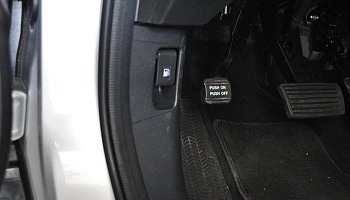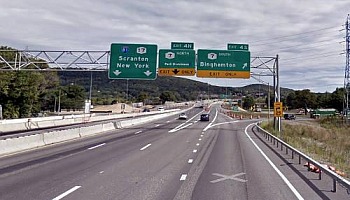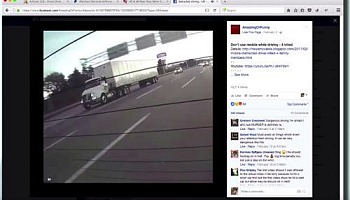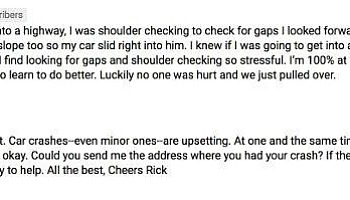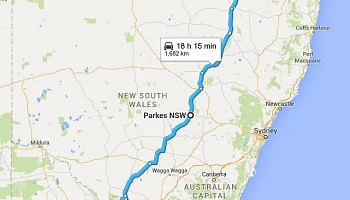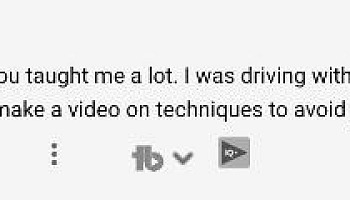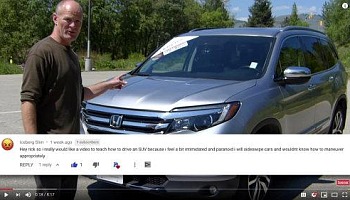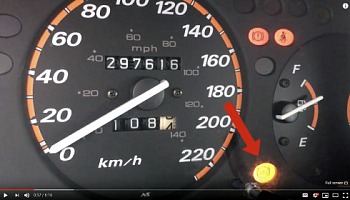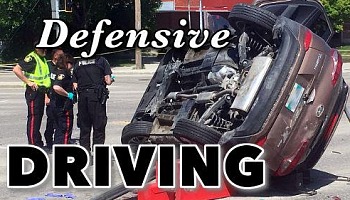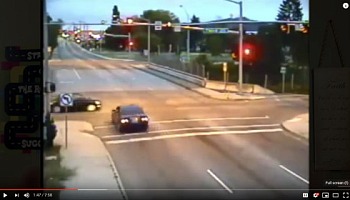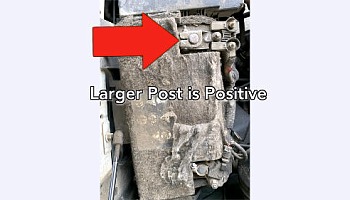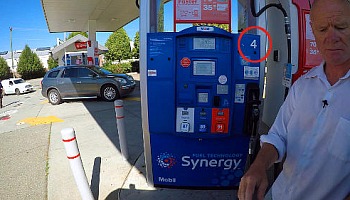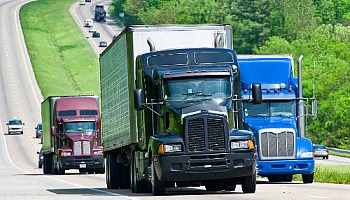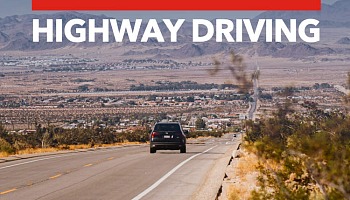Learn how to deal with traffic congestion and slow downs - watch the video.
How to Deal With Rush Hour, Traffic Congestion and Slow Downs
Closed Caption
Introduction
Hi there smart driver. Rick with Smart Drive Test talking to you today about congestion and traffic slowdowns which usually happen on highways, freeways and interstates. If you drive on the them long enough you will experience slow down or backups due to traffic crashes, traffic volume, or stuff falling off the back of the trucks or other people and animals being on the roadway where there shouldn't be. So it is going to happen. Now just before we get started here, make sure you hit that subscribe button down over - about there if you're working towards your license or starting your career as a truck or bus driver - hit that subscribe button and get all the great information as I get it available to you.
Now, traffic congestion - a couple of recent trips - one in Vancouver I experienced traffic back up. Actually it was one of the few times the traffic actually came to a standstill and I actually turned around and went back and found an alternative route. In Toronto I experienced back up on the Gardiner Expressway in a recent trip there and it was simply due to traffic volume.
So we're going to talk about traffic volume today, back up, and what you do in that situation to sort of calm yourself down, and not get excited because unfortunately what happens in traffic congestion is that you don't know what's going on, you don't know whether it's due to traffic volume, you don't know whether it's due to a crash, or some other unforeseen event such as the sinkhole here in Vernon, BC, Canada that we've recently had here in the spring due to all the water we had recently. So stick around, we'll be right back with that information.
Prologue
Hi there smart drivers, welcome back. Rick with Smart Drive Test talking to you today about traffic congestion. Yes, at certain times of the day you are going to have traffic congestion in and around large metropolitan areas, regardless of where you are in the world - London in England, Cincinnati in the United States, in the state of Ohio, Vancouver, British Columbia, Canada, Toronto, Ontario, Canada.
All these large metropolitan cities are going to have interstates, motorways, and freeways. And those freeways, without fail during the business days of the week are going to have rush hours in the morning and in the afternoon.
Driving Truck Into Toronto
And years ago, when I drove truck into Toronto. If you were heading eastbound on the #401, we had a saying that if you didn't get past the MM299, which was the big Schneider Meats sign by 5:00 o'clock in the morning you were going to sit in traffic in Toronto. And for those of you who haven't been to Toronto, through Toronto is eight lanes of traffic going east and west. There are four through lanes--the Express lanes--and then there are four collector lanes.
If you've been to any of the big United States cities, most of the big US cities have ring roads, which means there are freeways going around the city that move to facilitate traffic flow in and around the city. And I have sat in Atlanta, Georgia on six lanes of interstate traffic going in either direction, in bumper-to-bumper traffic in the afternoon during rush hour. So the first defense against sitting in traffic and experiencing traffic congestion is to plan the time of your trip. If at all possible, avoid seven o'clock to ten o'clock in the morning. Because if you travel on an interstate in and around a metropolitan area between 7:00 and 10:00 in the morning, you know you're going to sit in traffic.
Likewise, if you're heading out of the metropolitan area in the afternoon between 3 and 6:30pm, you also know that there's going to be congestion. There's going to be rush-hour. So plan your trip accordingly. Do not try and come out of the city between three and six thirty in the afternoon. Now that's going to vary a little bit depending on which metropolitan area you are in and around. And you will get to know that if you are driving in and out of the city for work every day.
| PASS YOUR DRIVER'S TEST WITH OUR COMPREHENSIVE CHECKLIST! |
Alternative Forms of Transportation
Now if you are driving in and out of the major metropolitan areas from the outer suburbs or one of the communities one of what they call the bedroom communities, where people live and sleep and then commute into town. There are alternative forms of transportation. In Toronto, they have the GO-train. And lots of transit systems will allow you to Park and Ride, where you can park your vehicle and then take the train or the local transit system into town. That's an alternative.
Listen to Audio Books
Now if you do end up sitting in traffic and do commute into town every day, you know that, so you're going to listen to a news story on the radio, you're going to go and get audio books, and those types of things. Now a few years ago, Zig Ziglar was saying that if you listen to audiobooks in a car during your travels and commute for a period of up to two years, it's comparable to doing a master's degree at a university. So there is a lot of learning that can go on while you're in your car.
Now I do encourage you not to do distracted driving - all those things that drivers do in the daily grind and commute of going back and forth in and out of a major metropolitan areas.
You know shaving, eating, putting on makeup, drinking coffee - all those types of things. Try not to do that while you're driving. You can get some work done while you're driving if you need to make phone calls and those types of things, but certainly make sure that you're on a hands-free set.
Plan Your Trips
Now if you are in traffic, as I said previously, plan your trips accordingly so you're not going in and out of the major urban centers during rush hour. Now obviously, in the morning, traffic's going to be going into town, so if you're coming out of town you're probably going to be all right. Now in the afternoon, traffic is coming out of town, so if you're going into town, you're probably going to be alright. You know that.
Unforeseen Events
There are unforeseen things that do happen on freeways that cause freeways to slow down or shut down - sinkholes, you know animals get out on the freeways, and those types of things. People are wondering around for whatever reason on the freeway, those types of things and traffic crashes obviously will slow down and shut down the freeway.
Freeway Dangers
Now one of the things that you need to be careful about on freeways if the freeway backs up for whatever reason and the traffic behind you is not coming to a stop yet. Make sure that you put your 4-way flashers, and make sure you keep lots of distance between you and the vehicles in front of you. That way, when you see the traffic coming up behind you you can simply move up and you're not going to get rear-ended. And I'll put a video up here for you on how to defend against being rear-ended in your vehicle, especially on a freeway.
Awful Rear-End Collisions on Freeways
Because there have been some awful, awful incidents of vehicles plowing into the back of other vehicles that are queued up to get on off an off-ramp or queued up because the traffic backed up for whatever reason that it may have backed up. So know that, have a look at the rear-end video, so that you don't get rear-ended on a freeway.
Stay Back from the Traffic in Front
Now saying that, the other tactics that you keep in place while you're crawling along in the backed up traffic is stay back from the vehicle in front of you. Yes, you're going to have a gap there and other people are going to try and get in and those types of things and whatnot - just let them go and have their crash somewhere else. You've got to stay back because sitting in traffic and driving slowly--bumper-to-bumper and it just kind of grinding along--it is distracting. You're watching, you're looking at other vehicles, and the vehicle moves forward, and you move forward. And you know if you got space, you're not going to drive into the vehicle in front of you.
And it's less likely that you're going to get rear-ended by the vehicle behind you. So make sure you keep space between you and the vehicles in front you. You don't have to be right up tight to them. It's not required - it doesn't matter if somebody gets in front of you.
Other Drives are Going to Take Your Space
People are going to cut, they're going to try and move over, they're going to get around, they're going to go in the utility lane and they're going to turn around on the freeway, and those types of things. Just let them go. Yes, it is frustrating, its you're on edge when the traffic's backed up, you don't know what's going on, you don't know how long it's going to last - yes, but take a breath. Have your audiobooks and just try as much as possible to relax.
You’re Going to Be Late
In Vancouver here, where we got backed up in traffic -and actually it's been a couple of times now that I've been running for the ferry in Vancouver and got stuck in traffic. You know, we missed the ferry. We were two hours late and so instead of getting to Vancouver Island at 9:30 at night, we ended up getting to Vancouver Island at 11:30 at night. But we got there safely, and nobody was injured, nobody was hurt but it was one of the few times that we'd sat in traffic for almost 90 minutes before I decided that it was time to turn around and go back and find an alternative route.
Emergency Crews
So sometimes if emergency services - if there is a traffic crash, they are really good about it. Tune into the local radio stations. They will have traffic reports and you can figure out what to do. If emergency services are on it they'll have people out there detouring the traffic and moving it around to alternative routes and try and getting it around a major crash or some other incidents that has caused the freeway to be shut down.
Rare to Shut Down the Freeway
But it's a rare incident that they actually shut the freeway down completely. And you know try and merge, try and be conscious of other people, and try... you know...help other people to merge and those types of things to try and move the traffic forward.
What are Those Truck Bloody Doing?
Now one other thing that you might find on a freeway is if there's congestion and construction where two lanes are moving into one lane to get past construction you may find two large commercial vehicles that sit beside each other and actually kind of crawl forward and hold the traffic back. I've actually been in trucks that have done that because it's a great deal of work for truck drivers to be in stop-and-go traffic because you're holding the clutch in, you're letting the clutch out, you're putting the thing in, you're shifting a couple of gears. It's much easier for two trucks to drive at a slow speed--at a constant speed--and much less exhausting and then when you get up to where you need to merge the one truck moves in front of the other. So try not to curse the trucks out or try not to get in on the shoulder because stop-and-go traffic for truck drivers and bus drivers is probably one of the most onerous things that you have to do.
It is much easier to move at a constant slow speed in a truck than it is to move in that stop and go traffic. So if you ever get behind two trucks that are doing that and blocking the traffic and holding it back, that's the reason they're doing it. And actually, you're probably going to get through the congestion much faster with those two trucks doing that then you are in stop- and-go traffic. So know that if that happens to you and that's what's going on. That's what's happening in congestion.
Relax, Breath, You’re Going to Get There
And as well, just take a breath - have your books, listen to the news, figure out what's going on if you are in for an inordinate amount of time and whatnot. I'm talking about inordinate - anything beyond half an hour or forty-five minutes. You might want to find an alternative route. But for the most part, in my experience, it has only been a couple of times in all the years I've been driving that I've actually been in traffic that stopped. Most of the time, within 15 or 20 minutes, the slowed down traffic will speed up and take off again. So you're usually not going to sit in backed up traffic for very long.
Conclusion
Quick review of traffic congestion. Plan your trips accordingly - know there's going to be rush hour in the morning and rush hour in the afternoon. In the morning, all of the traffic is going into the city. So if you're going into the city in the morning between 7:00 and 9:00 or say 6:30 and 9:00 o'clock, you're going to be sitting in traffic.
If you're coming out of the city in the afternoon between three and six thirty, you too are going to be sitting in traffic.
Unfortunately for some of those who live in the outer suburbs of these large metropolitan areas and commute back and forth every day, you're going to sit in traffic. If you're driving your car, some of the ways that you can combat that sitting in traffic and knowing you're sitting in traffic is stay back from the vehicles in front of you.
Get a couple car lengths, listen to some of the news stations, some of the public broadcasting systems that have these shows on them - these talk shows--they're quite interesting and entertaining. As well, go to the library or purchase audiobooks. Audiobooks are really great to listen to in your car.
Actually there was a study a couple years ago--I think it was Zig Ziglar--he was saying that if you listen to two years of audiobooks in a car while you're driving it's comparable to doing a master's degree. So there is a great deal of learning that can be done while you're spending time in your vehicle.
Now if you're sitting in traffic, don't do all those distracting things, like talking on your phone, and putting on makeup, and shaving, and eating and all of the other things that we do on the freeway in traffic. Listen to audiobooks - it's good for your brain - good exercise for your brain. So that's another way you can do it. And I know you're on edge, it's frustrating because you don't know what's happening, you don't know the reason that the traffic is slowed down or backed up, whether it's a traffic crash, or how soon it's going to get going, and those types of things.
So there's a lot of unknown variables in terms of backup and traffic crashes and other events that cause traffic to back up on interstates, freeways, and motorways. So know that, take your time, keep your space, and have something in the car that you can do or listen to - a story or something like that. If you've got kids in the car, as well, go to the library and get those books and there's a CD accompanying the book and you put the CD in the radio and they can look in the book and read along with this the CD on the radio.
So that's another thing you can do with your kids if you're driving on freeways and know that you're going to be around metropolitan areas and probably end up in congestion that unfortunately will extend the length of your trip.
Question for my smart drivers:
What is your experience sitting in congestion? What is your worst experience of sitting in congestion?
Leave a comment down in the comment section there, all of that helps the new drivers learning how to drive and avoiding rush hour.
If you like what you see here share, subscribe, leave a comment down in the comment section. As well, hit that thumbs up button. Check out all the videos here on the channel if you're working towards a license or starting your career as a truck driver truck or bus driver. Lots of great information here.
As well, header head over to my website - awesome information over there and tremendous online courses that you can purchase. All the courses for a license are guaranteed to pass first time or your money back. In June 2017 we're bringing out "Air Brakes Explained Simply." It's an air brake manual that updates the 40-year-old air brakes currently in circulation in North America. As well, there's a hundred multiple-choice questions that will give you feedback and prepare you for your theory test for your CDL air brakes. I'm Rick with Smart Drive Test. Thanks very much for watching. Good luck on your road test. And remember pick the best answer not necessarily the right answer. Have a great day. Bye now.

